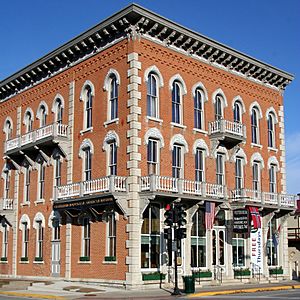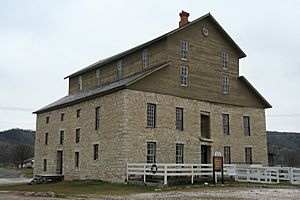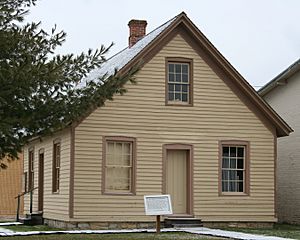Vesterheim Norwegian-American Museum facts for kids
 |
|
| Location | 502 West Water Street Decorah, Iowa, United States |
|---|---|
The Vesterheim Norwegian-American Museum in Decorah, Iowa is a special museum and school that teaches about Norwegian-American history and art. It has more than 33,000 old items, 12 historic buildings, and a library. This museum has one of the biggest collections of Norwegian-American items anywhere. It shows off amazing old and new Norwegian folk art. Some of its buildings are so important that they are listed as historic places.
Vesterheim's exhibits help people understand the many different stories of immigrants coming to America, especially from Norway. The museum also offers classes where students can learn traditional folk art. Vesterheim also has events, books, and talks that teach more about its mission.
History of Vesterheim Museum
Vesterheim Museum started in 1877. It was first called the Norwegian-American Historic Museum. It began as part of Luther College, which is nearby. In 1965, the museum became its own independent group. It had its own staff and leaders. Soon after, it was called Vesterheim Norwegian-American Museum.
In 1969, Luther College loaned its old items to the museum. By 1991, the museum officially owned these items. Its name was then changed to "Vesterheim Norwegian-American Museum." The word Vesterheim means 'western home' in the Norwegian language.
The Main Building and Heritage Park
The museum's main building used to be the Arlington Hotel and Publishing House. Luther College bought this empty building in 1932. The museum's collection was moved there in 1933. Luther College sold the building to Vesterheim for just $1.00 in 1969. In 1973, the museum bought land behind the main building. This land would become the Heritage Park.
Early Curators and Collections
The museum's first curator was Haldor Hanson. He worked there from 1895 to 1902. He was a music professor at Luther College. He changed the museum's focus to show the everyday life of Norwegian-Americans. He did this by combining items Luther College already had with new ones.
Christian Keyser Preus was curator from 1911 to 1921. He got the idea for an "Open Air Division" for the museum. He saw a collection of buildings at a museum in Norway called Maihaugen. Between 1921 and 1930, four buildings were moved to the Luther College campus. This was the first outdoor museum of its kind in the United States.
Knut Gjerset was curator from 1922 to 1935. Under his leadership, the museum got many more items. It also became more well-known. In 1925, Norway celebrated 100 years of Norwegians moving to America. Museums in Norway gave many items to the museum in Decorah. Anders Sandvig, Maihaugen's curator, helped collect and send these gifts. They filled five large trucks when they arrived in the United States.
In 1930, Gjerset bought 6,000 Norwegian-American items. This was called the P. D. Peterson Collection. Museums in Norway gave another large gift in 1939.
Vesterheim's Folk Art School
Vesterheim's Folk Art School started in 1967. It began with two classes. One was Hardanger embroidery, taught by Carola Schmidt. The other was rosemaling, taught by Sigmund Aarseth from Norway.
The folk art program grew quickly. In 1968, it had five classes with 63 students from 12 states. Today, the school offers over 100 classes each year. These classes include fiber arts, painting, woodworking, and more. They are held both at the museum and online.
The "National Norwegian-American Folk Art Exhibition" also began in 1967. This yearly event shows art from artists across the country. Artists compete for ribbons in five areas: rosemaling, weaving, woodcarving, knifemaking, and metalworking. They can also earn points toward a Vesterheim Gold Medal.
Heritage Park: Historic Buildings
Heritage Park is a collection of 12 historic buildings. They are located behind the museum's main building. These buildings show what life was like for Norwegian immigrants.
Painter-Bernatz Mill
The Painter-Bernatz Mill is in Heritage Park. It was added to the National Register of Historic Places in 1974. William Painter built this old stone mill in 1851. He was one of the first European settlers in Winneshiek County. Many believe it is the oldest building in Decorah.
Norris Miller House
The Norris Miller House is also in Heritage Park. Norris Miller was a carpenter from Ohio. He built this house in Decorah in 1856. It was added to the National Register of Historic Places in 1976.
Haugan House
Norwegian immigrants Hans and Anna Haugan built this house. It was on a farm southeast of Decorah in the 1860s. They lived there until at least 1880. The house is a good example of a husmann dwelling. This was a simple home used by tenant farmers in Norway in the 1800s.
Valdres House
This house shows what a typical Norwegian landowner's home looked like. The Valdres House was built around 1795 in Norway. It was made bigger in the 1860s. Vesterheim got the house thanks to rosemaler Sigmund Aarseth. It was taken apart and shipped to Vesterheim in 1975-76. Norwegian carpenters then put it back together.
Egge-Koren House
Erik Egge built this house in 1852 on his farm near Decorah. In 1853, he married Helen Pedersdatter. From December 1853 to March 1854, Rev. Ulrik Vilhelm Koren and his wife Elisabeth lived with the Egges. Koren was an important Lutheran minister. He helped Norwegian immigrants in America. Elisabeth Koren wrote a diary. It describes what it was like for four adults and two children to live in a small, one-room log house during the winter.
Norsvin Mill
The Norsvin Mill was built in Norway in the 1800s. Knut Norswing gave it to the Luther College Museum. He wanted it to hold the millstones his grandfather, Knut Norsvin, brought to America.
Rovang Parochial Schoolhouse
The Rovang Parochial Schoolhouse was built in 1879. It was built by the Washington Prairie Lutheran Congregation. For two weeks each school term, children of Norwegian immigrants could attend this school. They learned about their Norwegian heritage. This included speech, language, writing, and religion.
Tasa Drying Shed
The Tasa Drying Shed was built around 1865 by Knut Thompson Tasa. It was used to dry barley for making beer. People also used it to dry grains for food or as a bath house.
Mikkelson-Skree Blacksmith Shop
The Mikkelson-Skree Blacksmith Shop was in Houston County, Minnesota. It was moved to Vesterheim's Heritage Park in 1971. Mikkel Mikkelson Sinnes built it around 1854. It was used as both a home and a blacksmith shop. It looks like blacksmith shops found in Norway.
Wickney House
The Wickney House was built by Anders Vikne (Wickney) in 1879. It was on a farm in Northwood, North Dakota. Anders' granddaughter, Ruth Wickney, gave the house and most of its furniture to the museum. It was moved to its current spot in 1982.
Erikson-Hansen Stabbur
The Erikson-Hansen Stabbur was built by Hans Erikson in Byron, Minnesota. It was used to store food. It was built on stone pillars to keep out mice and other animals. The stabbur was moved to its current spot in 1988.
Bethania Lutheran Church
Bethania Lutheran Church was a country church. It was built in 1903 near Northwood, North Dakota. Vesterheim Director Marion Nelson was looking for an altar made by Osten Pladsen. He found one in this church, which was up for sale.
Church and religion were very important to Norwegian immigrants. So, the museum decided to buy the whole church. This included its pews, communion rail, pulpit, and baptismal font. These items were also built by Pladsen. The altar itself had already been given to Vesterheim. The church was moved to its current spot in 1992.



